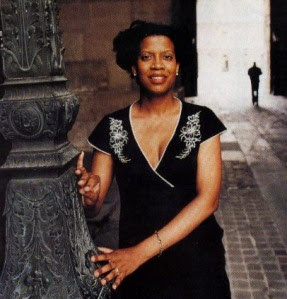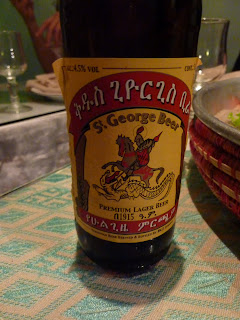© Discover Paris!
© Discover Paris!
Owner Alpha Diallo is proud of the restaurant’s zinc bar, a holdover from the days when an old-time bistrot occupied the locale. The bar stands at the entrance of the principal dining room, which is dimly lit and has tall windows that stretch fully across its width. Although long, the room is rather narrow, and there is just enough space for a person to move between the rows of tables.
© Discover Paris!
Several mixed-media paintings by artist Laurence Galand hang on maize-colored walls.
© Discover Paris!
A French artist-in-residence at Seine-et-Marne, Galand creates paintings and sculptures from reclaimed materials at beaches and on city streets. She says that her art will hang at Sunugal as long as Mr. Diallo wishes, so it is likely that you will find at least one or two of her works there at any time.
A single portrait by Cameroonian photographer Mario Epanya remains on display from a previous exposition:
© Discover Paris!
With a background in fashion as a makeup and hair artist, Epanya publishes a bimonthly beauty magazine called Winkler.
When Tom and I entered the restaurant, Mr. Diallo greeted us and personally ushered us to our table. Having noticed that I was slightly stuffy, he recommended that I try a Punch gingembre as a bracer against my cold. He said that he uses ginger himself for throat ailments, and brought me a heated concoction of hot water, ginger juice, rum, and lime. It was delicious and I did not refuse when our waitress offered to refill my glass later in the meal! Tom ordered Punch coco, a rum drink served with ice and coconut milk in a tall glass. We both munched on green olives in a spicy mustard sauce and peanuts as we perused the menu.
© Discover Paris!
As a starter, we decided to split a plate containing four Pastels – Senegalese fritters stuffed with a dark-meat fish. Though I don’t care for fish, I found the fritters to be quite good. Light and slightly crunchy, they were served with a spicy onion sauce for dipping.
Tom was eager to try the restaurant’s award-winning Thieboudienne. (Sunugal won the Marmite d’Or for its preparation of this classic dish.) He was served a thick cut of fish smothered in flavorsome gravy with a large mound of rice and big morsels of cabbage, manioc, carrot, eggplant, and turnip, and a single, whole okra pod on the side. He found the dish to be very appetizing: the fish was firm, yet it yielded to the pressure of a fork; the carrot, manioc, and turnip were cooked firm to the bite; and the eggplant, okra, and cabbage retained their savory flavors.
© Discover Paris!
For my main course, I selected Thiébou Yapp – two sizable morsels of stewed lamb shoulder covered with an onion and olive sauce. The meat was tender and flavorful. A huge mound of short-grain rice cooked in dark gravy accompanied the dish.
During the meal, Mr. Diallo brought over a small dish of fond de marmite—crispy grains of rice that are found at the bottom of the stew pot. When sprinkled on the food, these savory grains provided a delicious, crunchy counterpoint to the meal.
As a beverage accompaniment, Tom ordered Gazelle, a slightly-bitter, blond beer from Senegal served in 63cl bottles. Still fighting my impending cold, I ordered another Punch gingembre.
For dessert, Mr. Diallo recommended a dish that was not on the menu. Called Thiacry, it is a homemade sweet pudding made with millet, crème fraîche, and yogurt. Tom ordered it and declared it to be rich and sweet and sour at the same time. He said that it was a refreshing dessert.
I ordered Beignets sénégalais, three balls of slightly sweet, somewhat chewy, fried dough flavored with spices and served with crème chantilly. I have never seen such a dessert in other Senegalese restaurants, so I decided to give it a try. While flavorful, the level of sweetness was less than what I anticipated, particularly in comparison to the sweet mint tea that we were served afterward. This beverage could have served as dessert on its own!
While we dined, African music played over the sound system until a local singer, Moussa Kanouté, arrived to sing and play his kora, an African harp. We were able to meet him and shake his hand during one of his breaks.
© Discover Paris!
We returned to Sunugal several days after this first dining experience and sat at the zinc bar. We struck up a conversation with a man there, who we learned is a regular at the restaurant. When the subject of the specialties of the house came up, he stated that he considered “conviviality” to be topmost at the restaurant. Indeed, we had a lively, enjoyable chat with him and the servers behind the bar as we watched the restaurant fill with customers. I ordered bissap juice and was intrigued by the unique, refreshing taste of this beverage – different than any other I have tasted before! I learned that Diallo adds orange water, a bit of pineapple juice, and a little sugar to his hibiscus infusion. The next time we visit the restaurant, I’ll be ordering an entire pitcher!
As renovations are scheduled for Sunugal, we anticipate that it will look quite different when we return. We think, though, that the food, drink, and hospitality will remain as excellent as we have found it!
Sunugal
3, rue Crespin de Gast
75011 Paris
Telephone: 01.48.06.86.30
Internet: www.resto-sunugal.com
Metro: Menilmontant (Line 2)
************
Go Gourmet with Discover Paris! We can show you the best of the city’s pastry and chocolate shops, arrange a private wine hop, organize a dinner in an authentic Parisian home prepared by a private chef, help you plan your Paris picnic…To learn more, visit our gourmet itinerary page at www.discoverparis.net/gourmet.html or send a message to info[at]discoverparis[dot]net. Click here to access our free Paris Insights restaurant reviews!
************
Entrée to Black Paris!™ is a Discover Paris! blog.
If you liked this article, share it with your friends and colleagues by clicking on one or more of the social media buttons below!
If you liked this article, share it with your friends and colleagues by clicking on one or more of the social media buttons below!

















































